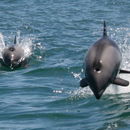Diagnostic Description
provided by FAO species catalogs
Heavisides's dolphin is one of the most poorly known of all cetaceans. The shape of the body is similar to that in other Cephalorhynchus dolphins: stocky, with a short blunt snout, and blunt-tipped flippers. The dorsal fin is more triangular than the rounded fins of the other genus members, but it is taller than in most porpoises. The body is predominantly grey, with a dark cape, which starts at the blowhole, remains extremely narrow in the thoracic region and then widens to dip low on the side below the dorsal fin. The area around the eye and much of the face is often darker grey. There is a white ventral patch that begins just behind the flippers, and splits into arms behind the umbilicus. The middle arm encloses the urogenital area and the side arms extend only to below the midline. There is also a white diamond-shaped patch between the anterior insertions of the flippers, and separate white spots in the axillae. Several predominantly white individuals have been seen. Heaviside's dolphins have 22 to 28 small, sharp teeth in each tooth row. Can be confused with: The only other small cetaceans within this species' range are larger dolphins, whose falcate dorsal fins should be easy to distinguish.
- bibliographic citation
- Marine mammals of the world. Jefferson, T.A., S. Leatherwood & M.A. Webber - 1993. FAO species identification guide. Rome, FAO. 320 p. 587 figs. .
- author
- Food and Agriculture Organization of the UN
Size
provided by FAO species catalogs
Adults of this species are up to about 1.7 m in length. Newborn size is unknown, but is likely to be somewhat less than 1 m.
- bibliographic citation
- Marine mammals of the world. Jefferson, T.A., S. Leatherwood & M.A. Webber - 1993. FAO species identification guide. Rome, FAO. 320 p. 587 figs. .
- author
- Food and Agriculture Organization of the UN
Brief Summary
provided by FAO species catalogs
Very little is known of the biology of this species. They are seen mostly in small groups of less than 10, with pairs and trios being most common. Heaviside's dolphins are not generally active or boisterous, but they are known to ride bow waves on occasion. Essentially, nothing is known of their reproductive biology. The available information on feeding is meagre, but Heaviside's dolphins are known to eat several varieties of fish and cephalopods.
- bibliographic citation
- Marine mammals of the world. Jefferson, T.A., S. Leatherwood & M.A. Webber - 1993. FAO species identification guide. Rome, FAO. 320 p. 587 figs. .
- author
- Food and Agriculture Organization of the UN
Benefits
provided by FAO species catalogs
Gillnets and other types of coastal fishing gear (trawls and purse seines) represent threats to Heaviside's dolphins, but there is little information on numbers of animals taken. There may also be some direct hunting by harpoon and other means. IUCN: Insufficiently known.
- bibliographic citation
- Marine mammals of the world. Jefferson, T.A., S. Leatherwood & M.A. Webber - 1993. FAO species identification guide. Rome, FAO. 320 p. 587 figs. .
- author
- Food and Agriculture Organization of the UN

